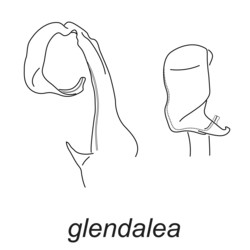Brachoria glendalea
The Glendale Hills Mimic Millipede
Paul MarekCharacteristics
Brachoria glendalea individuals are about 40.5 mm long and 10.7 mm wide (females 42.7 mm X 10.8). Color: 2-spotted yellow.


Brachoria glendalea genitalia - left male gonopodal acropodite (with setae removed): (Left) medial view and (Right) magnified apical view. © Paul Marek
Habitat
Brachoria glendalea specimens were collected during the day (9:30 and 13:00) in two localities: at the type locality, in a disturbed area in Nashville, and at Radnor Lake State Nature Preserve. I found two millipedes within the city limits of Nashville, one of which, a large female, I did not collect. The Nashville locality is a shaded and disturbed gully with Hedera helix blanketing a large part of the soil. No other xystodesmids were encountered sympatrically here. Brachoria glendalea from Radnor Lake were found in a maple, birch, and tulip poplar forest in a moist gully. One other xystodesmid encountered co-occurring at the Radnor Lake locality is Falloria mimetica.Distribution
Known from the Interior Plateau of Tennessee in Davidson County south through Marshall County and into Maury, Bedford, and Coffee counties; and west to Hickman County. The closest known Brachoria species, B. initialis occurs south and east of B. glendalea. Brachoria hubrichti occurs east in the environs of the Cumberland Plateau and Sequatchie Valley.Conservation status
Brachoria glendalea is threatened by habitat loss due to agriculture (especially growing demand for paper products), coal mining, development, and the invasion of exotic species.References
Marek P.E. 2010. A revision of the Appalachian millipede genus Brachoria Chamberlin, 1939 (Polydesmida: Xystodesmidae: Apheloriini). Zool. J. Linn. Soc. 159: 817-889.
Chamberlin R.V. 1918. Myriapods from Nashville, Tennessee. Psyche 25: 23-30.
Chamberlin R.V., Hoffman RL. 1958. Checklist of the millipeds of North America. Bull. U.S. Nat. Mus. 212: 1-236.
Keeton W.T. 1959. A revision of the millipede genus Brachoria (Polydesmida: Xystodesmidae) Proc. US Nat. Mus. 109: 1-58.
Hoffman R.L. 1999. Checklist of the millipeds of North and Middle America. Virginia Museum of Natural History Special Publication. No. 8. Martinsville: Virginia Museum of Natural History.
Title Illustrations

| Scientific Name | Brachoria glendalea |
|---|---|
| Location | USA, Tennessee, Davidson Co. |
| Reference | Marek P.E. 2010. A revision of the Appalachian millipede genus Brachoria Chamberlin, 1939 (Polydesmida: Xystodesmidae: Apheloriini). Zool. J. Linn. Soc. 159: 817-889. |
| Specimen Condition | Live Specimen |
| Sex | m |
| Life Cycle Stage | adult |
| View | dorsal |
| Collection | FMNH |
| Collector | Paul Marek |
| Image Use |
 This media file is licensed under the Creative Commons Attribution-NonCommercial License - Version 3.0. This media file is licensed under the Creative Commons Attribution-NonCommercial License - Version 3.0.
|
| Copyright |
© Paul Marek

|
About This Page
Work on the millipede Tree of Life pages was supported by a U.S. National Science Foundation Doctoral Dissertation Improvement Grant to Paul Marek and Jason Bond (DEB 0607996) and a Partnerships for Enhancing Expertise in Taxonomy Grant to Petra Sierwald, Jason Bond, and William Shear (DEB 0529715).
Paul Marek

Virginia Polytechnic Institute and State University
Correspondence regarding this page should be directed to Paul Marek at
brachoria@gmail.com
Page copyright © 2010 Paul Marek
 Page: Tree of Life
Brachoria glendalea . The Glendale Hills Mimic Millipede.
Authored by
Paul Marek.
The TEXT of this page is licensed under the
Creative Commons Attribution-NonCommercial License - Version 3.0. Note that images and other media
featured on this page are each governed by their own license, and they may or may not be available
for reuse. Click on an image or a media link to access the media data window, which provides the
relevant licensing information. For the general terms and conditions of ToL material reuse and
redistribution, please see the Tree of Life Copyright
Policies.
Page: Tree of Life
Brachoria glendalea . The Glendale Hills Mimic Millipede.
Authored by
Paul Marek.
The TEXT of this page is licensed under the
Creative Commons Attribution-NonCommercial License - Version 3.0. Note that images and other media
featured on this page are each governed by their own license, and they may or may not be available
for reuse. Click on an image or a media link to access the media data window, which provides the
relevant licensing information. For the general terms and conditions of ToL material reuse and
redistribution, please see the Tree of Life Copyright
Policies.
- First online 16 September 2010
- Content changed 16 September 2010
Citing this page:
Marek, Paul. 2010. Brachoria glendalea . The Glendale Hills Mimic Millipede. Version 16 September 2010 (under construction). http://tolweb.org/Brachoria_glendalea/144218/2010.09.16 in The Tree of Life Web Project, http://tolweb.org/






 Go to quick links
Go to quick search
Go to navigation for this section of the ToL site
Go to detailed links for the ToL site
Go to quick links
Go to quick search
Go to navigation for this section of the ToL site
Go to detailed links for the ToL site